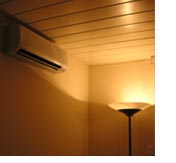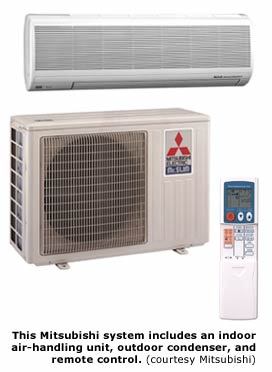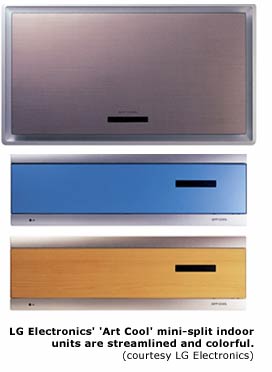Eichler Air Conditioning
 Eichler homeowners throughout California have struggled with staying cool during the warm summer months.
Eichler homeowners throughout California have struggled with staying cool during the warm summer months.
The Eichler's large single-pane windows, while effective for maximizing natural light, promote solar gain. Equally problematic in summer heat is the Eichler's original installation of tar-and-gravel roofing, which was underlined with minimal insulation. Between the window heat gain and the lack of roofing insulation and reflectivity, Eichlers have been known to become transformed into large hot boxes on a hot summer day.
In the past, residential cooling was limited mainly to a pair of undesirable options, including HVAC (heating, ventilation, and air conditioning) units that featured a large, obtrusive box and a network of unsightly ductwork mounted on top of the roof that clashed with the Eichler aesthetic.
A second HVAC option was the window-type air conditioning units, designed to cool a small area or room. This type left Eichler homeowners with holes in their walls, loss of window space, and noisy, ugly boxes attached to the sides of their homes. Usually four or five of these units were needed to adequately cool the house. High energy consumption was another of their drawbacks.
Fortunately Eichler owners today have much more functional and appealing cooling options. With the emergence of certain products from Asia, maintaining a comfortable temperature in an Eichler can be achieved without the noise, high utility costs, or unsightliness.

One product that fits that bill is the ductless mini-split system, which was invented in Japan following World War II. At the time, the Japanese were looking for an alternative to conventional air conditioning, since the size and noise of conventional units were incompatible with the small spaces and high population density of Japanese living. The result was a split-type ductless system that was quiet, compact, energy efficient, and designed for room-by-room cooling.
The ductless mini-split system is comprised of two main components: an outdoor condenser (roughly 20x30x10 inches) and an indoor air-handling unit (roughly 10x33 x7 inches). These two components are linked with a conduit, which houses electrical, refrigerant tubing, and a condensate drain.
The beauty of this setup is that the conduit is no more than three inches in diameter, making it possible to install these systems in a more aesthetically unobtrusive way, especially when compared to the alternatives. The conduit can be installed through the roof, or through exterior walls. The condensate can be drained to the outside, or as some homeowners have done, through the drain in the laundry room. The second option is popular with Eichler owners who prefer no roof penetrations.
These systems can help keep your home safe, since there are no large openings in the wall or window—often invitations for intruders. Another benefit of the mini-split installation is that the condenser can be tucked alongside of the house or in an area of the yard where it's not noticeable. In addition, this unit is quiet and will not disturb occupants or neighbors. This factor is especially important today as more and more towns implement noise ordinances that target air conditioning systems.
The indoor unit is narrow, fits nicely against the interior wall, and can be placed in between beams to be less noticeable. Some Eichler owners have created cosmetic encasements to disguise the indoor units and blend them into their home's décor. Each indoor unit operates independent of the other, which makes it easy to control the temperature in specific rooms and further save energy consumption. The indoor units come in various sizes to cool areas up to 1,000 square feet.
The condenser can also be located as far as 40 feet from the air-handling unit, making it easier to tuck it away on the side or back of the house. One condenser, depending on its capacity, can support as many as four air-handling units.
Another desirable feature of the mini-split system is the integration of an optional heat pump at installation. Not only can the heat pump be used to cool the home, but it can also produce timely supplemental indoor heat by reversing the air conditioning process.

Even though the Eichler's slab-generated radiant-heat system produces subtle, friendly heat, it unfortunately still has its drawbacks. But when the mini-split is used in conjunction with the radiant system, as a supplemental heat source, it addresses two common complaints of Eichler owners.




